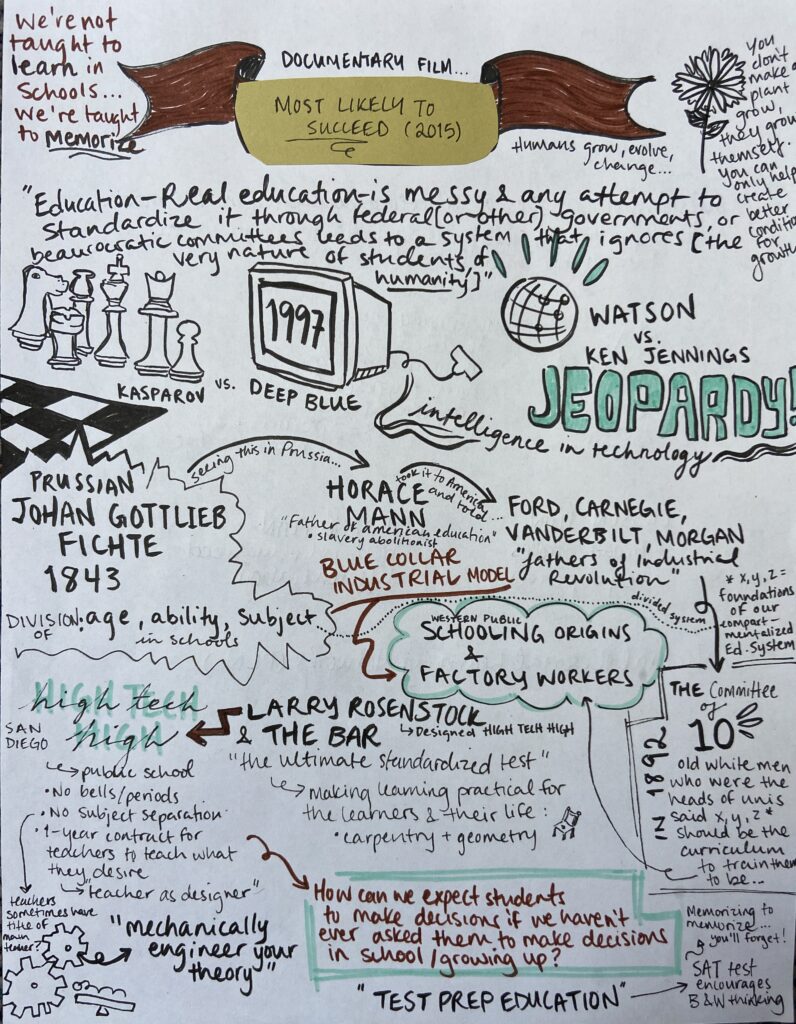What obstacles do educators often face when they try to change they way they teach?
The documentary “Most Likely to Succeed” (2015) highlighted the educational approach of High Tech High—a school in San Diego, California that challenges the Euro-centric model of schooling we know today. I took a sketchnote overview while watching:

This film comes to mind when thinking about obstacles teachers face when trying to change education because of the examples highlighted throughout. Even though, as the documentary points out, it seems our existing systems are broken because they often teach students how to memorize to ace tests rather than being taught to learn, this is not the reaction many students and parents have to education that is not centred around test prep. There is a sort of comfort in this system, even though there is ample evidence to suggest it does not lead to success. Convincing parents and students of the importance of learning for life’s-sake, rather than for the sake of getting into University is a definite challenge.
“Most Likely to Succeed” shared a bit about the history of the Eurocentric education models we use today. I was interested in learning more…
In the early 1800s, a Prussian man named Johan Gottlieb Fichte decided that changes to education were necessary. His second address to the German Nation in 1807, The General Nature of the New Education, shares the goal of ‘remedying’ the nation through education. He starts by expressing his concerns about the ‘old’ education system, “that very recognition of, and reliance upon, free will in the pupil is the first mistake of the old system and the clear confession of its impotence and futility.” This new system of education aimed to, “destroy[…] free will so that after pupils are thus schooled they will be incapable throughout the rest of their lives of thinking or acting otherwise than as their school masters would have wished.” Putting stricter guidelines on the structure of students’ days shifted the education model toward militaristic training. At this time, the primary intention of implementing this model appears to be producing obedient soldiers.
In this same address, Fichte says, “The schools must fashion the person, and fashion him in such a way, that he simply cannot will otherwise than what you wish him to will.” To me, this sounds like blatant brainwashing.
After Hoarace Mann saw this model in Prussia, he took the concepts and implemented them in America. This model was adapted by a bunch of white men who were heads of universities called the Committee of 10 in the second half of the 19th century. The intention of using this model was to mould students into factory workers, who are trained to be governed by a bell and react like obedient soldiers. Over the years, this has shifted into the system of schooling that many of us know well—with the division of age, ability and subject.
It seems the intention of this new models is as far from Indigenous teaching pedagogies as possible. As Gregory Cajete shares in the Appendix (“An Outline of Indigenous Teaching and Learning Orientations”) of Look to the Mountain, (1994) “Indigenous teachers see that each student is unique and has a path of learning that they need to travel during their life. […] The trials, tribulations, and work that become a part of each individual’s learning path constitute the basis for some of the most important contexts of Indigenous teaching and learning.”
I noticed a lot of the intentionality behind the model of education at High Tech High is quite aligned with Indigenous teaching pedagogies, like the axioms highlighted by Cajete, as well as the First Peoples Principles of Learning from the First Nations Education Steering Committee (FNESC). I think that “learning is holistic, reflexive, reflective, experiential, and relational,” was particularly aligned with the goals of High Tech High. While the model at High Tech High seemed to align in these ways, the film fails to acknowledge Indigenous knowledge systems and frames these concepts as novel.